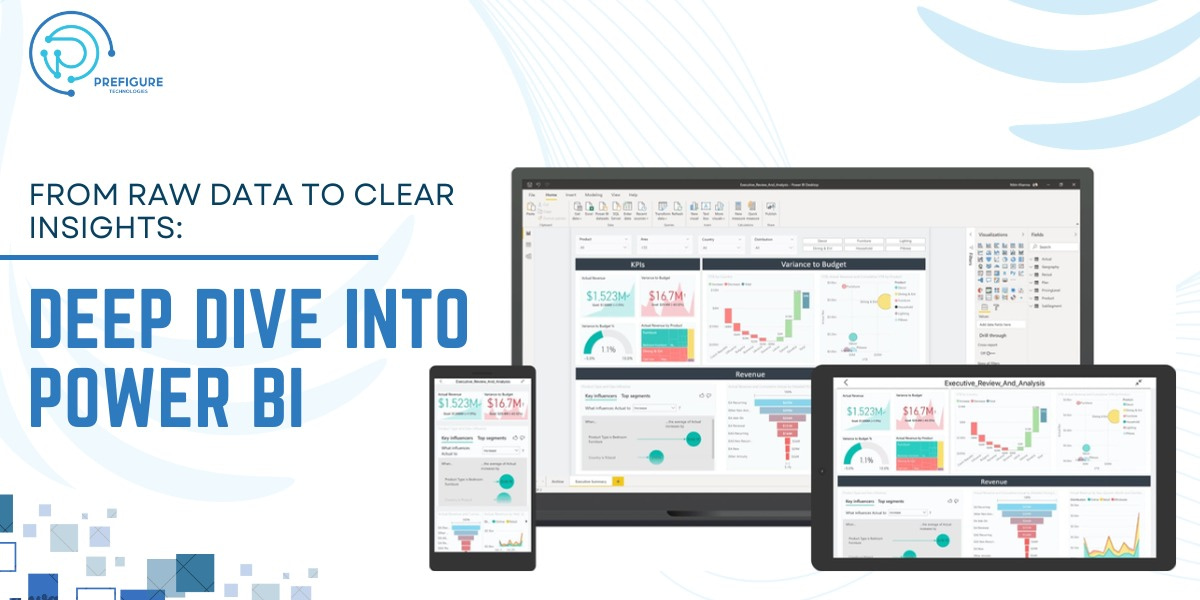Vipul Sharma, 25 September
Table of Contents
1. Introduction:
Data analysis has become an essential part of decision-making processes in various industries. In today’s data-driven world, businesses need efficient tools to transform raw data into clear and actionable insights. Power BI, a powerful business intelligence tool developed by Microsoft, has emerged as a leading solution in this field.

With its user-friendly interface, extensive data visualization options, and seamless integration with other Microsoft products, Power BI has revolutionized the way organizations analyze and interpret their data. In this blog, we will take a deep dive into the features, benefits, and applications of Power BI and explore how it can empower businesses to make informed decisions based on accurate and comprehensive insights.
2. The Significance Of Data Visualization In Business Intelligence:
In the world of business intelligence, data visualization plays a crucial role in turning raw data into meaningful insights. Traditional methods of analyzing data, such as spreadsheets and static reports, often fail to communicate complex information efficiently. This is where Power BI shines.
With its intuitive drag-and-drop interface and a wide range of visual elements, Power BI allows users to transform complex data into interactive and visually appealing visualizations. Whether it is a bar chart, line graph, or map, Power BI empowers users to represent data in a way that is easily understood and analyzed.
By leveraging the power of data visualization, businesses can unlock hidden patterns, identify trends, and communicate insights effectively. Visualizations enable stakeholders to grasp information quickly and make informed decisions. Through interactive dashboards, decision-makers can explore data from various angles, drill down into specific details, and obtain real-time updates.
Moreover, data visualization goes beyond just presenting information. It enables users to spot outliers, detect correlations, and comprehend the underlying relationships between different variables. With Power BI, businesses can go beyond numbers and uncover actionable insights that drive growth and success.
3. Understanding the basics of Power BI:
Now that we have established the importance of data visualization in business intelligence, let’s delve into the basics of Power BI. Power BI is a leading business analytics tool developed by Microsoft. It provides a comprehensive suite of features that make it an essential tool for data visualization and analysis.
The core components of Power BI include
Power BI Desktop is a powerful tool that enables users to create interactive reports and visualizations. It allows users to connect to a wide range of data sources, including databases, spreadsheets, and cloud services.
Power BI Service, on the other hand, is a cloud-based service that allows users to share, collaborate, and publish reports and dashboards. It provides a centralized platform where users can access and interact with shared reports, ensuring that everyone is on the same page.
Last but not least, Power BI Mobile brings the power of data visualization to your fingertips. With the Power BI Mobile app, users can access their reports and dashboards on the go, making informed decisions anytime, anywhere.
In the subsequent sections, we will explore each component in more detail, uncovering their unique features and functionalities. By the end of this blog series, you will have a comprehensive understanding of Power BI and its potential to transform raw data into clear insights.
4. Importing and transforming your raw data in Power BI:
Now that we have explored the basics of Power BI, it’s time to dive into one of its core functionalities – importing and transforming raw data. Power BI provides a wide range of options for importing data, allowing you to connect to various data sources and bring them to life in a meaningful way.
With Power BI Desktop, you can easily connect to data sources such as databases, spreadsheets, and cloud services. Once connected, you can transform the raw data using Power Query, a powerful ETL (Extract, Transform, Load) tool within Power BI. Power Query allows you to clean, reshape, and combine data from different sources, ensuring that you have a complete and accurate dataset to work with.
Additionally, Power BI offers a wide range of data transformation functionalities, such as filtering, sorting, and grouping, making it easy to prepare your data for analysis. You can also apply advanced transformations, such as adding calculated columns, creating custom measures, and merging tables, to further enhance your dataset.
5. Creating Visually Stunning And Interactive Reports:
With your data imported and transformed in Power BI, it’s time to take it to the next level and create visually stunning and interactive reports. Power BI offers a wide range of visualization options that allow you to present your insights in a compelling and engaging way.
One of the key features of Power BI is its extensive library of visuals. Whether you need charts, graphs, maps, or tables, Power BI has got you covered. You can choose from a variety of pre-built visuals or even create your own custom visuals using the Power BI Developer Tools.
Once you have selected your visuals, you can easily drag and drop your data onto the canvas to create meaningful visualizations. With just a few clicks, you can customize the appearance, formatting, and labeling of your visuals to ensure they convey the message you want to convey.
But it doesn’t stop there. Power BI offers a range of interactive features that allow your audience to explore the data on their own. From drill-throughs and filtering to slicers and bookmarks, you can empower your users to interact with the data and discover their own insights.
6. Utilizing Power BI’s Advanced Analytics Features:
Now that you have mastered the art of creating visually stunning and interactive reports in Power BI, it’s time to delve into the platform’s advanced analytics features. These features take your data analysis to the next level, allowing you to uncover deep insights and make data-driven decisions with confidence.
Power BI offers a wide range of advanced analytics capabilities that are designed to help you extract even more value from your data. One such feature is the ability to perform complex calculations using DAX (Data Analysis Expressions), a powerful formula language. With DAX, you can create custom calculations and measures that go beyond the standard aggregations and calculations offered by Power BI.
Another powerful feature of Power BI is its integration with R and Python, two popular programming languages for data analysis. By incorporating R or Python scripts into your Power BI workflows, you can leverage their extensive libraries and algorithms to perform advanced statistical analysis, predictive modeling, and machine learning tasks.
In addition to DAX and R/Python integration, Power BI also provides a set of built-in AI-powered features. These include the ability to create AI-powered visuals, detect outliers, perform sentiment analysis, and make use of machine learning algorithms, all within the familiar Power BI interface.
By utilizing Power BI’s advanced analytics features, you can take your data analysis to new heights. Whether you are performing complex calculations, incorporating advanced statistical techniques, or leveraging AI-powered capabilities, Power BI has the tools and capabilities to help you gain deeper insights from your data.
7. Sharing And Collaborating On Insights With Others:
Once you have transformed raw data into clear insights using Power BI’s advanced analytics features, the next step is to share and collaborate with others. After all, data analysis is most impactful when it is shared and discussed among teams, stakeholders, or clients.
With Power BI, sharing and collaborating on insights is seamless. You can easily publish your reports and dashboards to the Power BI service, where they can be accessed by others with the appropriate permissions. This allows your colleagues or clients to view and interact with the insights you have created, even if they don’t have Power BI installed on their devices.
Collaboration is made even easier with Power BI’s commenting feature, which enables users to leave comments, ask questions, and have conversations directly within the reports or dashboards. This promotes real-time collaboration, enhances teamwork, and fosters better decision-making based on shared insights.
Not only can you share and collaborate within your organization, but Power BI also provides the option to securely share insights with external stakeholders. By using the sharing feature, you can grant access to specific individuals or groups outside your organization, ensuring that they only see the data you want them to see.
If you prefer to collaborate in real-time, Power BI offers a co-authoring feature where multiple users can work on the same report or dashboard simultaneously. This allows for faster collaboration, eliminates version control issues, and ensures that everyone is working with the most up-to-date data.
In addition to sharing and collaborating on insights, Power BI provides various options for embedding your reports and dashboards into other applications or websites. This way, you can seamlessly integrate your data analysis into existing workflows, making it easily accessible to everyone who needs it. Sharing and collaborating on insights is a crucial part of the data analysis process, and Power BI makes it simple and efficient.
8. Conclusion: Harnessing The Power Of Power BI For Informed Decision-Making:
In this blog series, we have explored the various features and capabilities of Power BI that transform raw data into clear insights. From data cleaning and modeling to creating visually appealing and interactive reports, Power BI offers a comprehensive solution for data analysis.
But the journey doesn’t end with generating insights. Sharing and collaborating on those insights is equally important. With Power BI’s seamless sharing and collaboration features, you can ensure that your hard work doesn’t go unnoticed. Whether it’s within your organization or with external stakeholders, Power BI allows you to securely share your reports and dashboards.
Collaboration is made even easier with features like commenting and co-authoring, promoting real-time discussions, and fostering better decision-making based on shared insights. Furthermore, embedding reports and dashboards into other applications or websites ensures that your data analysis is easily accessible to everyone who needs it.
By harnessing the power of Power BI, you can enable informed decision-making across your organization, drive better outcomes, and gain a competitive edge in today’s data-driven world.
Thank you for joining us on this deep dive into Power BI. We hope that you found this series informative and valuable. If you have any questions or would like further assistance with Power BI, don’t hesitate to reach out. Happy analyzing!

